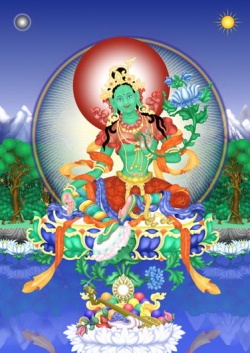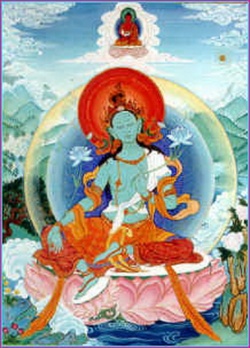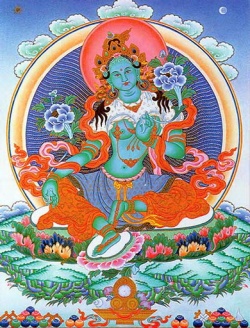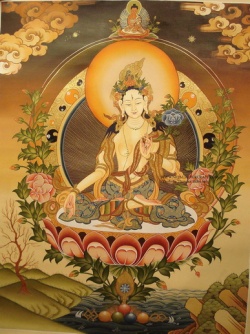Green Tara – 8 Offerings
The 8 Traditional Offerings
The eight offerings are made in seven bowls and a lamp. Beginning on the right, the offerings are water for drinking, water for washing, flowers, incense, light, perfumed water, food, and music.
BOWL 1: Argham (Chod yon): water for drinking
BOWL 2: Padhyam (Shab sil): water for washing.
BOWL 3: Pushpe (Me tog): Flowers.
BOWL 4: Dhuppe (Dug po): Incense (this is not burned).
BOWL 5: Gendhe (Dri Chab): Water, perfumed.
BOWL 6: Nivide (Shalse): Food.
BOWL 7: Symbol of Music. (ie: Shell, bell, cymbals)
LIGHT 8: Diya – place in front of statue behind the row of seven bowls.
Tea lights can also be used. Traditionally, it is said you should never blow out the flame, it is the same as putting out the breath of your own life. However, based on my tribal island heritage, I believe that ‘breath to breath’ we fuel intent by adding our life source to that of the devine.
Placement of the Bowls and Diya:
The seven bowls must be carefully lined and are usually kept about a grain of rice apart from each other. It is said that too much space between the bowls predicts a distance from your precious teacher. The Light (Diya) is placed behind the bowls, in front of the statue. Preparing the offerings:
WATER Bowls 1, 2, 5: Wash, Drink, Perfume Bowls containing water must be filled up each night and emptied each morning as an offering to a household plant. The offering bowls should be cleaned, dried and placed upside down on the altar. An empty bowl is never left upright on an altar as it may cause resources to leave you. It is advised that a container be reserved for the purpose of filling the bowls each night. Traditionally, Sandalwood powder or oil is added to 2nd offering bowl, and perfume/rosewater to the 5th Bowl. Fill each bowl, generously as close to the top as possible, leaving approximately a grain of rice spacing to the top of the bowls. Overflowing is considered a lack of discipline but filling just above the rim is just the opposite. Flower, Incense, Food: Traditionally the bowls not containing water are filled with rice upon which you place the offered item. It is change when stale, and on each full moon, the ‘old’ rice offering it to the birds, fish or other animals. It is now known that rice can harm birds, I recommend using bird seed, or nuts as the base for the bowls. As with the rice, change if it starts to get ‘old’ and on full moon and with my tradition, new moon, as an offering to the animals. Bless the offerings. Take some water in the perfumed water bowl (fifth bowl), soak the end of a piece of kush grass, and sprinkle the offerings, reciting the mantra: RAM YAM KAM OM AH HUNG x 3.
RAM -purify: represents the fire that burns the impurities.
YAM – purify: represents the wind that sweeps them clean
KAM – purify: represents the water that washes the offerings
OM – bless: represents the Body
AH – bless: represents the Speech
HUNG – bless: represents the Mind
After the blessing, as a sign of homage, do three Namaste bows.Alternate simplified offering:
There is a more simple method of offering that may also be used. This offering consists of filling seven bowls of water each night, emptying them each morningA deeper look at the spiritual significance of the offerings:
1. Drinking Water
The first offering is that of pure drinking water. Offering water to cleanse the mouth or face: It signifies auspiciousness or all the positive causes and conditions which bring positive effects. So, make an offering of water which is clean, fresh, cool, smooth, light, delicious, comfortable to the throat and stomach – these qualities are the qualities of auspiciousness.It is offered with the thought that whatever benefit one accumulates may, for the present, bring about the annihilation of suffering through thirst among beings. Especially beings in realms such as the pretas, or hungry ghosts, may receive relief from the suffering of thirst. The offering is also made so that ultimately all beings may be permeated by loving kindness and compassion.
2. Bathing Water:
This is clear water mixed with incense or sandalwood which is made as an offering to all enlightened beings’ feet. The symbolic meaning is purification. By cleansing the feet of the enlightened beings, we cleanse all our own negative karma and obscurations. By making offerings to clean the enlightened beings feet, we are really cleaning the “feet” of our own mind.Bathing waters are offered to the body of the Buddhas, not because they need cleansing, but because by making such an offering to the objects of refuge, sufficient merit may be gained to bring about physical purification and cleansing of our own bodies, which are subject to negativity and are very vulnerable. The offering is also made, ultimately, to dissolve obscurations that interfere with meditation, that block Dharma understanding, and to purify all obstacles to Dharma practice.
3. Flowers:
Offering flowers signifies the practice of generosity and opens the heart. It awakens one to beautify their surroundings, though the gift of flowers is quite unnecessary in the perfection of their Buddha realms. Again it is for the benefit of those who make the offering and it is made with the intention that all beings might find noble forms to inhabit, and ultimately, that all beings might embody in their forms all of the marks and attributes of enlightenment, like the awakened ones.
4. Incense:
Offering incense symbolises moral ethics or discipline. Incense is offered so that the annihilation of all unpleasant and unhealthful smells may take place, and, ultimately, that the merit accumulated might bring about the realization of perfection of the profound scent of discipline. It has been said that whoever has perfected the discipline is surrounded by a sweet fragrance.
5. Perfume:
Offering of perfume or the fragrance from saffron or sandalwood. It signifies perseverance or joyous effort. Through that one quality, one develops all the qualities of enlightenment.We make the offering so that temporarily all negative patterns may be purified, such as aggression, ignorance and attachment, and that ultimately not only the habitual patterns of beings but also the outer environment may become purified and perfected.
6. Food:
The seventh offering is the offering of food. Offering of food which has a lot of different tastes signifies samadhi, which is a nectar or ambrosia to feed the mind.The awakened ones have no need to indulge in material food offerings, but the purpose of such offerings made to the enlightened objects of refuge is to temporarily relieve suffering that beings experience through hunger and starvation, and to bring about an abundance of food. Ultimately, the offering is made so that beings may experience the perfect state of meditation, of samadhi, and that all beings may live on the spontaneous food of meditation.
7. Sound:
Their nature is wisdom, which makes an offering to the ears of the Buddhas and Bodhisattvas and all the enlightened beings. Sound represents wisdom because wisdom is a special power of the mind which penetrates phenomena. Compassion is achieved through great wisdom; interdependence of all phenomena is realised through great wisdom. of course all phenomena have the nature of interdependence, causes and conditions, but sound is especially easy to understand.
8. Light:
The fifth offering is the offering of the lamp. The awakened ones, seeing through their wisdom eyes, have no need for such a small light, yet the offering of it is made with the thought that ignorance may be purified in all beings. It is made so that ultimately the merit of such offerings of light might cause the transcendental knowledge and experience to become manifest in all beings just as it has in the Buddhas and enlightened ones.



